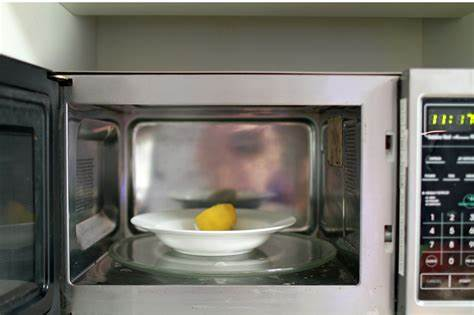Mastering Microwave Cleaning with Vinegar Welcome to the world of effortless microwave cleaning with vinegar. In this comprehensive guide, we’ll explore advanced techniques, tips, and in-depth insights for achieving a spotless kitchen without breaking a sweat. I’m Angela Brown, a Cleaning Expert, and I’m here to share the secrets that will transform your cleaning routine
Mastering Microwave Cleaning with Vinegar
Welcome to the world of effortless microwave cleaning with vinegar. In this comprehensive guide, we’ll explore advanced techniques, tips, and in-depth insights for achieving a spotless kitchen without breaking a sweat. I’m Angela Brown, a Cleaning Expert, and I’m here to share the secrets that will transform your cleaning routine and leave your microwave sparkling. Let’s start by understanding why vinegar is a game-changer when it comes to cleaning. Vinegar is a natural and versatile cleaning agent. It’s an acid, which means it can break down mineral deposits and effectively remove stains. Here’s a closer look at the basics of vinegar Vinegar’s natural cleaning properties is attributed to its acidity.
The acid in vinegar dissolves mineral deposits, making it highly effective for cleaning tasks. It’s a safe, non-toxic, and eco-friendly alternative to commercial cleaning products. Whether you’re dealing with greasy splatters, food residues, or unpleasant odors in your microwave, vinegar can help. While white distilled vinegar is the most common type used for cleaning, there are other varieties worth exploring. Apple cider vinegar and white wine vinegar can work as effective alternatives, each with a slightly different scent and flavor. However, for most cleaning purposes, plain white vinegar does the trick.

Image by https://th.bing.com
Safety Measures
Before you dive into cleaning with vinegar, it’s essential to take some safety precautions. Here are a few key tips:
- Ventilation: Ensure there is proper ventilation in the kitchen. Vinegar can have a strong smell, so it’s wise to open a window or use a fan.
- Avoid Using on Stone Surfaces: Do not use vinegar on natural stone surfaces like granite or marble, as it can etch the stone.
- Test in an Inconspicuous Area: If you’re concerned about discoloration, test the vinegar on a small, inconspicuous area of your microwave first.
Tailoring the Process
Every kitchen and microwave are different. We’ll discuss how to adapt these advanced cleaning techniques to your specific kitchen setup and busy lifestyle. Customization is the key to success.

Image https://ceebeecleaning.com.
Troubleshooting Stubborn Stains
Microwave interiors can develop stubborn stains over time, particularly from food splatters and spills. If you find that standard cleaning methods with vinegar and water aren’t sufficient, there are alternative approaches: Create a paste by mixing baking soda with a small amount of water. Apply this paste to the stubborn stains and let it sit for about 5-10 minutes. The mild abrasive quality of baking soda, combined with vinegar’s cleaning power, can help lift and dissolve the stains. Afterward, gently scrub the stained areas with a toothbrush or a soft bristle brush. Another effective solution for stubborn stains is lemon juice. Squeeze fresh lemon juice into a microwave-safe bowl, add a cup of water, and heat the mixture for a few minutes. The steam generated by the lemon and water will help soften and loosen the stains. You can then wipe away the softened residue with a damp cloth or sponge.
KeyPoint:
| Preventative Care Tips | Description |
|---|---|
| Use Microwave-Safe Lids or Covers | When heating or cooking food in the microwave, always use microwave-safe lids, covers, or microwave-safe plates to prevent splatters. These covers help contain messes and reduce the chances of food residue accumulating on the microwave’s interior surfaces. |
| Cover Foods with Paper Towels | For foods that are prone to splattering, such as sauces or soups, place a microwave-safe paper towel or microwave-safe plate on top of the container. This helps absorb any splatters and keeps the microwave cleaner. |
| Rotate Food | To ensure even heating and minimize the potential for localized splatters, pause cooking at regular intervals to rotate or stir your food. |
| Wipe Spills Promptly | If a spill or splatter occurs during cooking, wipe it away immediately with a damp cloth or paper towel. This prevents the residue from hardening and becoming more challenging to clean later. |
Conclusion:
In the quest for a spotless and efficiently functioning microwave, the journey of cleaning and maintenance can be greatly simplified by following the advanced techniques, tips, and in-depth insights presented in this guide. Angela Brown, our trusted Cleaning Expert, has illuminated the path to effortless microwave cleaning using the magic of vinegar. The advanced cleaning techniques explored in this guide, such as steam cleaning and deodorizing with vinegar, offer a straightforward and eco-friendly way to tackle even the most stubborn microwave stains and odors. With the right tools and solutions, you can restore your microwave to its pristine condition with minimal effort. Troubleshooting and maintenance tips have been thoroughly discussed to help you address common issues and maintain a clean microwave over time. From dealing with stubborn stains using baking soda and lemon juice to preventative care through the use of microwave-safe covers and timely spill cleanup, these practices will keep your microwave looking great and working optimally.

















Leave a Comment
Your email address will not be published. Required fields are marked with *